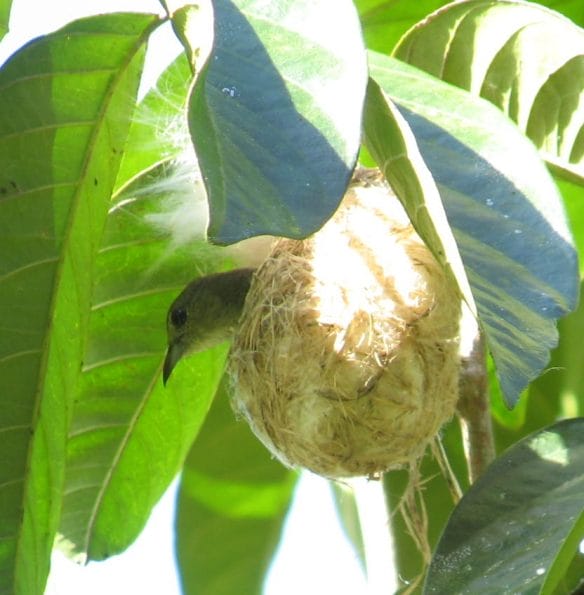Carmela Balcazar shares the first observations and photographs of a Pygmy Flowerpecker nest. In A Guide to the Birds of the Philippines it says of this bird ” Probably breeds throughout the year with records in Feb, Apr, Jul, and Dec. Nest and eggs unknown”.
C
Close Encounter of the Unrecorded Kind
by Carmela Balcazar
space
Living and working in a farm has its perks. You are bound to be constantly reminded that delightful and unexpected discoveries can take place anytime if one is observant enough. However, I don’t know which interrupts one another, birding or work. But the answer is obvious on which activity I would rather do. Consequently, when a nest is discovered, it becomes part of the daily routine to check on how the family is doing. I find myself going out of my way and using every excuse to peep. Unfortunately, time constraints and the demands of work can only give a small window of opportunity to observe so my notes are few.
For several days, I noticed that Pygmy Flowerpeckers (Dicaeum pygmaeum) were very visible and noisy on a particular site prompting me to wait and observe.

Jan. 1, 2012 – They led me to their nest 18 ft. up (5.5 meters) high on a Lanzones (Lansium domesticum) tree.*
The overall height of the tree is 25 ft. (7.6 m). The nest was located one third of the way back from the apex of an upright branch. This was a good strategic move since as the leaves matured; they grew longer providing more protection from the elements for the nest when the chicks hatched. This was proven during the days from Jan. 2-6, when it rained ranging from light to heavy downpour and the nest remained dry.

Jan. 13 – I detected movement. Couldn’t tell if it was the mom or the chicks. The shape of the nest is globular but as the chicks grew and gained weight, it started to become oblate. The opening of the nest faced the east and sticking out from the entrance were filaments similar to those of the long, silky stamens of the Powder Puff (Calliandra haematocephala).*
Though I would at times catch both of the pair of Pygmy Flowerpeckers hovering around the nest, I only saw the female actively entering and sitting in it.

Jan. 18 – At 12:00 noon, 2 little heads were peering out.
Jan. 28 – 2 very noisy fledglings were perched in an adjoining tree. Couldn’t tell if they were from the nest. No movement were seen coming from the nest since then…
Remnants of the nest revealed that inflorescences from grass species like talahib (Saccharum spontaneum) or (Setaria geniculata) thickly lined the nest. Both plant species are found in the farm and gardens.
It was Des Allen who brought it to my attention that the Pygmy Flowerpecker nest is unrecorded in the Kennedy Guide of Philippine Birds. Once again, I am reminded that each and every one of us can and do play a vital role in sharing what we find. With the little knowledge I have gained from this experience, my eyes will now be on the lookout for more nests. Who knows? It just might be of the unrecorded kind.
*Source: A Pictorial Cyclopedia of Philippine Ornamental Plants by Dr. Domingo Madulid
Lansium domesticum: Its leaves are alternate, odd-pinnate to 40 cm long. Leaflets are oblong or elliptic oblong to 18 cm. long and acuminate.


this is a good account of the pygmy flowerpecker. this information will be useful for researcher probably you can write a paper and submit it to a journal such as forktail.
I was researching how flowerpeckers everywhere had white cottony stuff showing through their outer nest material. How do they get access to the same kind of white down regardless of their geographical location. Well, thank you for specifying the two grasses whose flowers your flowerpeckers have used- my question has at least been partially answered! Lovely post, good info, nice pictures!!
The nesting site was near grasslands and at the edge of an unmanicured lawn. I suspect forest edges would be ideal sites as they offer protection, and have easy access to food and nesting materials.